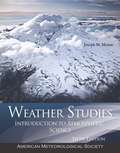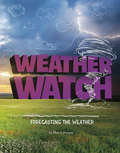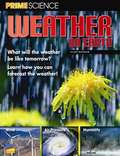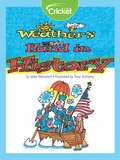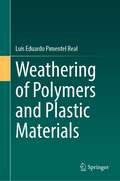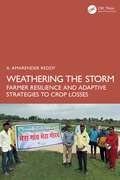- Table View
- List View
Weather Studies: Introduction to Atmospheric Science (Fifth Edition)
by Joseph M. Moran"The American Meteorological Society (AMS), founded in 1919, is a scientific and professional society. Interdisciplinary in its scope, the Society actively promotes the development and dissemination of information on the atmospheric and related oceanic and hydrologic sciences. AMS has more than 14,000 professional members from more than 100 countries and over 175 corporate and institutional members representing 40 countries. The Education Program is the initiative of the American Meteorological Society fostering the teaching of the atmospheric and related oceanic and hydrologic sciences at the precollege level and in community college, college and university programs. It is a unique partnership between scientists and educators at all levels with the ultimate goals of (1) attracting young people to further studies in science, mathematics and technology, and (2) promoting public scientific literacy. This is done via the development and dissemination of scientifically authentic, up-to-date, and instructionally sound learning and resource materials for teachers and students. AMS Weather Studies, a component of the AMS education initiative since 1999, is an introductory undergraduate meteorology course offered partially via the Internet in partnership with college and university faculty. AMS Weather Studies provides students with a comprehensive study of the principles of meteorology while simultaneously providing classroom and laboratory applications focused on current weather situations. It provides real experiences demonstrating the value of computers and electronic access to time-sensitive data and information. "
Weather Watch: Forecasting the Weather (Weather and Climate)
by Ellen LabrecqueWeather affects us every day. How do we know what the weather will be like where we live? How can we prepare for it? Find out the science behind weather observation and prediction.
Weather and Climate Patterns
by Janette SchusterWeather Patterns, The Water Cycle, Climate Patterns, Science and Engineering Practices, Careers.
Weather and Climate Science
by Glencoe Mcgraw-HillThis series brings together both the underpinning principles and new developments in meteorology for students, as well as being a useful resource for the professional meteorologist or Earth system scientist.
Weather and Climate Systems Student Guide and Source Book (STC Science and Technology Concepts Middle School)
by Smithsonian Science Education Center StaffGrades 6–8. This Student Guide and Source Book provides the student investigations, student goals and objectives, and reading selections for the Weather and Climate Systems unit.
Weather and Climate: Establishing an Orangutan Reserve
by The Lawrence Hall of ScienceNIMAC-sourced textbook
Weather and Climate: Establishing an Orangutan Reserve, Investigation Notebook (Amplify Science)
by The Lawrence Hall of ScienceNIMAC-sourced textbook
Weather and Water
by Lawrence Hall of Science University of California at BerkeleyNIMAC-sourced textbook
Weather and Water
by Lawrence Hall of Science University of California at BerkeleyNIMAC-sourced textbook
Weather and Water Resources
by University of California at Berkeley Lawrence Hall of ScienceNIMAC-sourced textbook
Weather and Water Resources: Images, Data and Readings
by Associates FOSS Middle School Project StaffThe book presents the weather and water resources around the world with images and related data and readings.
Weather and the Sun (Inspire Science, Grade K #Unit 3)
by McGraw-Hill EducationNIMAC-sourced textbook
Weather of Southern California (California Natural History Guides #17)
by Harry P. BaileyThis title is part of UC Press's Voices Revived program, which commemorates University of California Press’s mission to seek out and cultivate the brightest minds and give them voice, reach, and impact. Drawing on a backlist dating to 1893, Voices Revived makes high-quality, peer-reviewed scholarship accessible once again using print-on-demand technology. This title was originally published in 1966.
Weather on Earth
by Brett Kelly Hilary MaybaumFrom temperature to humidity to winds, this book tells you what you need to know about weather. You'll find out what causes weather, how and why it changes, and on what weather predictions are based. Learn how to interpret weather data and make your own weather forecasts! (Set of 10)
Weather on Earth
by Lawrence Hall of Science University of California at BerkeleyNIMAC-sourced textbook
Weather's Hand in History
by Mike WeinsteinWeather affects us almost every day. When it's raining, we can't play outside. Sometimes weather is even more important. Sometimes weather shapes history.
Weather, Religion and Climate Change (Routledge Environmental Humanities)
by Sigurd BergmannWeather, Religion and Climate Change is the first in-depth exploration of the fascinating way in which the weather impacts on the fields of religion, art, culture, history, science, and architecture. In critical dialogue with meteorology and climate science, this book takes the reader beyond the limits of contemporary thinking about the Anthropocene and explores whether a deeper awareness of weather might impact on the relationship between nature and self. Drawing on a wide range of examples, including paintings by J.M.W. Turner, medieval sacred architecture, and Aristotle’s classical Meteorologica, Bergmann examines a geographically and historically wide range of cultural practices, religious practices, and worldviews in which weather appears as a central, sacred force of life. He also examines the history of scientific meteorology and its ambivalent commodification today, as well as medieval "weather witchery" and biblical perceptions of weather as a kind of "barometer" of God’s love. Overall, this volume explores the notion that a new awareness of weather and its atmospheres can serve as a deep cultural and spiritual driving force that can overcome the limits of the Anthropocene and open a new path to the "Ecocene", the age of nature. Drawing on methodologies from religious studies, cultural studies, art history and architecture, philosophy, environmental ethics and aesthetics, history, and theology, this book will be of great interest to all those concerned with studying the environment from a transdisciplinary perspective on weather and wisdom.
Weathering of Polymers and Plastic Materials
by Luís Eduardo RealThis book presents the state of the art on the weathering of polymers and plastic materials in outdoor applications, comprising natural weathering, accelerated climatic weathering, laboratory artificial accelerated weathering, and lifetime prediction methodology. It summarizes the most suitable methods of instrumental analysis to access and quantify (when possible) degradation caused by weathering, while also covering the degradation and stabilization of polymers based on environmental and artificially induced factors. Innovative polymer additives and some developments in polymeric materials designed for outdoor applications are also included, emphasizing a few selected cases. the book intends to be an important reference source for those involved in the study of the durability of polymers and plastics, production of plastics for exterior applications, chemists responsible for quality control of plastic products, and researchers and students across plastics engineering, polymer science, polymer chemistry and environmental science.
Weathering the Storm: Farmer Resilience and Adaptive Strategies to Crop Losses
by A. Amarender ReddySmallholder farmers face relentless challenges from pests, diseases, and the severe impacts of climate change across developing countries. Each year, they endure droughts and floods, thrusting them into a vicious cycle of poverty and distress. Weathering the Storm: Farmer Resilience and Strategies for Crop Losses provides a vital exploration of these issues, offering insights into the struggles and resilience of farmers in the wake of devastating crop losses.Drawing on data from 1,440 farmers who faced severe crop losses in three states namely Telangana, Andhra Pradesh, and Karnataka of India, the book uncovers: Staggering Losses: Crop losses range from 30% to 100%, causing financial damages of three to five lakhs rupees per farmer Government Response: A critical analysis of various assistance programs, highlighting the effectiveness of schemes like the Pradhan Mantri Fasal Bima Yojana (PMFBY) and YSR free crop insurance Resilience Strategies: Insights into the self-adopted strategies farmers use to cope with challenges, alongside governmental support Effective Governance: Examines Andhra Pradesh’s decentralized governance model as a best practice for rapid response Farmers Distress Index (FDI): Introduction of an innovative forewarning system to identify farmers and areas in urgent need of intervention
